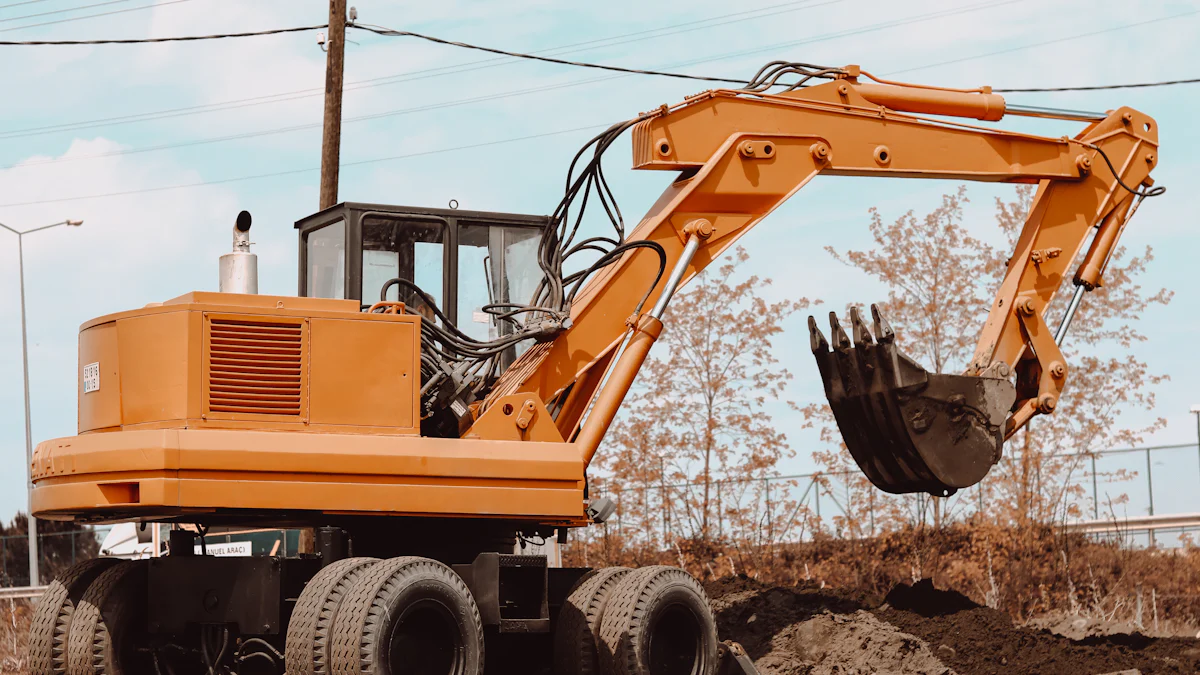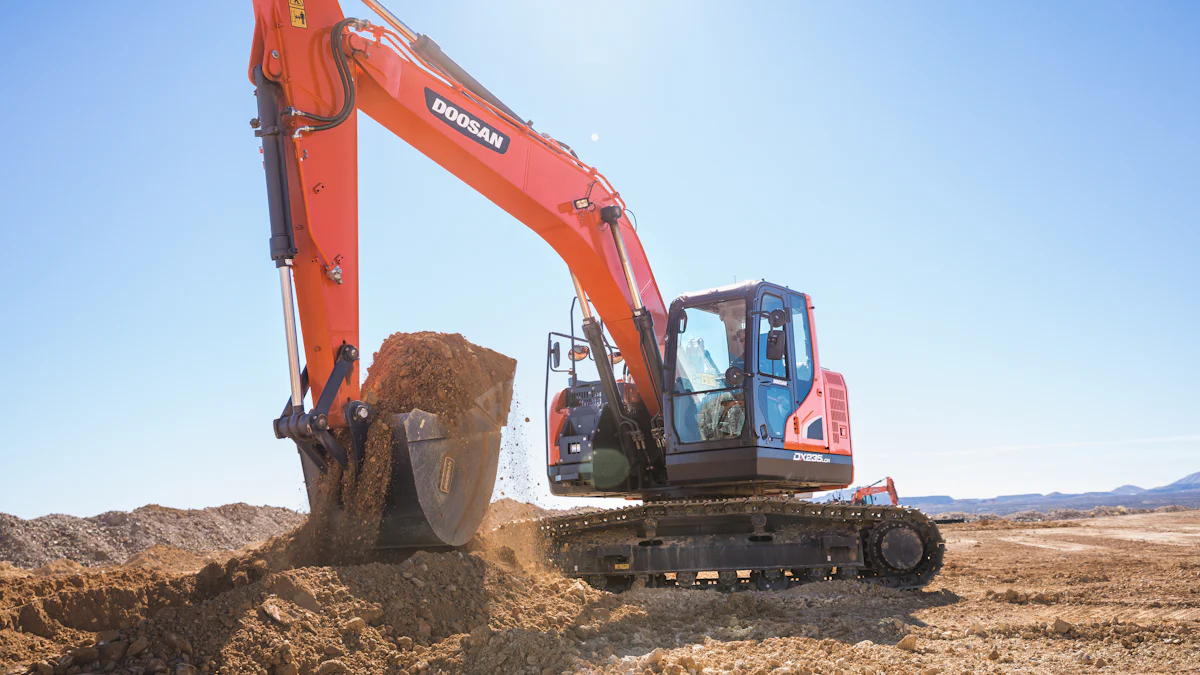
The John Deere 120 Excavator Parts Manual helps you save valuable time by simplifying the process of identifying and ordering the correct parts. With its clear layout and detailed information, you can quickly locate the components you need, reducing downtime and keeping your projects on schedule. Studies show that using equipment manuals improves efficiency and accuracy, saving technicians hours of work while minimizing errors.
Minimizing downtime is critical for maintaining productivity in construction projects. By addressing potential disruptions early, you ensure smoother operations and better project outcomes. YNF Machinery supports your maintenance needs with high-quality excavator parts, including engine parts, couplings, and hydraulic cylinder seal kits, ensuring your equipment performs at its best.
Key Takeaways
Use the table of contents to find sections fast. This saves time and helps you stay on task.
Learn from diagrams to see how parts connect. This helps you find the exact parts you need.
Always check part numbers before buying. Small mistakes cause delays and cost more.
Mark important sections in the manual for quick access. This makes repairs faster and easier.
Use the newest manual editions for correct information. This reduces mistakes and improves your work.
Understanding the Layout of the John Deere 120 Excavator Parts Manual

Key Sections of the Manual
Table of Contents and Index
The table of contents and index are your starting points for navigating the John Deere 120 Excavator Parts Manual. The table of contents provides a clear overview of the manual’s structure, listing all major sections and their corresponding page numbers. This allows you to quickly locate the section you need without flipping through every page. The index, located at the back, serves as a detailed reference tool. It lists specific terms, part names, and topics alphabetically, helping you find information with ease. For example, if you need details about a hydraulic pump, you can search for “hydraulic pump” in the index and go directly to the relevant page.
Exploded Diagrams and Illustrations
Exploded diagrams and illustrations are some of the most valuable features in the manual. These visuals break down complex assemblies into individual components, showing how each part fits together. They provide a clear understanding of the excavator’s internal structure, making it easier for you to identify the exact part you need. For instance, if you’re troubleshooting an issue with the boom cylinder, the diagram will show all related components, such as seals, pistons, and rods, in a detailed layout.
Part Numbers and Descriptions
Each part in the manual is accompanied by a unique part number and a detailed description. The part number ensures accuracy when ordering replacements, while the description provides additional context, such as the part’s function or compatibility. This combination eliminates guesswork and ensures you receive the correct component for your John Deere 120 excavator. By cross-referencing the part number with the description, you can confidently place your order.
How the Manual is Organized
Logical Grouping of Parts
The John Deere 120 Excavator Parts Manual organizes parts into logical groups based on their function or location within the machine. For example, engine components, hydraulic systems, and electrical parts are grouped separately. This structure simplifies your search process. If you’re working on the engine, you can focus on the engine section without distractions from unrelated parts.
Cross-Referencing Features
Cross-referencing features enhance the manual’s usability. Many sections include references to related parts or systems, guiding you to additional information. For instance, a diagram of the hydraulic system might include notes directing you to the seal kit section for maintenance details. These cross-references save time by connecting related information, ensuring you have all the details you need in one place.
Tip: Familiarize yourself with these sections to maximize the efficiency of your repairs and maintenance tasks. A well-organized manual like the John Deere 120 Excavator Parts Manual can significantly reduce downtime and improve productivity.
How to Quickly Find the Right Parts in the John Deere 120 Excavator Parts Manual

Using the Table of Contents and Index
Locating Specific Sections
The table of contents in the John Deere 120 Excavator Parts Manual provides a roadmap to the manual’s structure. It lists all major sections and their page numbers, allowing you to navigate directly to the area you need. For example, if you’re working on the hydraulic system, you can quickly find the relevant section without flipping through unrelated pages. This saves time and ensures you stay focused on the task at hand.
Searching for Keywords
The index, located at the back of the manual, is an essential tool for finding specific parts or topics. Organized alphabetically, it includes keywords, terms, and concepts with corresponding page numbers. If you need information about a specific component, such as a hydraulic pump, you can search for “hydraulic pump” in the index and go straight to the relevant page. This feature eliminates guesswork and speeds up your search process.
Interpreting Diagrams and Part Numbers
Understanding Exploded Views
Exploded diagrams in the manual break down complex assemblies into individual components. These visuals show how each part fits together, making it easier to identify the exact part you need. For instance, if you’re troubleshooting the boom cylinder, the diagram will display all related components, such as seals and rods, in a clear layout.
Matching Part Numbers to Descriptions
Each part in the manual comes with a unique part number and a detailed description. The part number ensures accuracy when ordering replacements, while the description provides additional context, such as the part’s function or compatibility. By cross-referencing these details, you can confidently identify and order the correct part.
Ordering the Correct Parts
Verifying Compatibility
Before placing an order, ensure the part is compatible with your excavator.
Confirm the part is designed for the John Deere 120 model.
Check dimensions, mounting points, and connection interfaces.
Avoid using incompatible parts, as they can cause inefficiencies or damage.
Double-Checking Part Numbers
Always double-check the part number before ordering. A small error in the number can result in receiving the wrong part, leading to delays and additional costs. Cross-reference the number with the manual to ensure accuracy.
Tip: Familiarize yourself with these steps to streamline your maintenance tasks. The John Deere 120 Excavator Parts Manual is a powerful tool for reducing downtime and improving efficiency.
Tips for Efficient Use of the John Deere 120 Excavator Parts Manual
Bookmarking Frequently Used Sections
Using Physical Bookmarks
Physical bookmarks can save you time when navigating the manual. Place bookmarks on sections you frequently reference, such as hydraulic systems or engine components. This method allows you to quickly flip to the desired section without searching through the entire manual. For example, if you often work on the boom cylinder, bookmarking that section ensures you can access it instantly.
Highlighting Key Pages
Highlighting key pages is another effective way to streamline your workflow. Use highlighters or sticky notes to mark important diagrams, part numbers, or troubleshooting guides. This visual cue helps you locate critical information faster, especially during urgent repairs.
Leveraging Digital Versions
Using Search Functionality
Digital versions of the manual offer advanced search features that make finding information effortless. You can type keywords like “hydraulic pump” or “seal kit” into the search bar and instantly access the relevant sections. This eliminates the need to flip through pages, significantly reducing downtime.
Accessing Updates Online
Digital manuals often include updates from manufacturers, ensuring you always have the latest information. These updates improve accuracy and help you avoid errors caused by outdated data. The table below highlights the benefits of using digital manuals:
Benefit | Description |
|---|---|
Efficiency | Technicians no longer waste time searching through paper manuals, reducing equipment downtime significantly. |
Accuracy | Technicians have access to the most up-to-date and accurate information supplied directly by manufacturers. |
Accessibility | Digital manuals are accessible from any device, enhancing field work flexibility. |
Cost Savings | Minimized downtime and streamlined maintenance processes lead to a more productive manufacturing environment. |
Scalability | The no-code system is adaptable to future expansions or updates, facilitating long-term growth and technological advancement. |
Keeping the Manual Updated
Replacing Outdated Versions
Regularly replacing outdated versions ensures your manual remains relevant. Manufacturers often release new editions with updated part numbers, diagrams, and troubleshooting tips. Using the latest version minimizes errors and enhances your efficiency.
Adding Notes for Quick Reference
Adding notes to your manual can make it more user-friendly. Write down part numbers, maintenance tips, or troubleshooting steps in the margins. These notes act as a personalized guide, helping you complete tasks faster.
Pro Tip: Engage with technical teams and end-users to gather feedback on improving the manual’s usability. Regular updates and logical organization make the manual a more effective tool.
Common Mistakes to Avoid When Using the John Deere 120 Excavator Parts Manual
Misreading Part Numbers
Double-Checking Numbers
Misreading part numbers is a common mistake that can lead to ordering the wrong components. Always double-check the numbers listed in the manual against the part you need. Even a single incorrect digit can result in delays and additional costs. Take your time to verify the numbers carefully before placing an order. This small step ensures you receive the correct part and avoid unnecessary downtime.
Avoiding Assumptions
Never assume that a part number is correct without confirmation. Cross-reference the number with the description provided in the manual. If you’re unsure, consult the exploded diagrams or illustrations to confirm the part’s location and function. Avoiding assumptions helps you make accurate decisions and keeps your maintenance tasks on track.
Skipping the Troubleshooting Section
Using Troubleshooting Guides
The troubleshooting section in the manual is a valuable resource. It provides immediate solutions to common equipment issues, minimizing downtime. By consulting this section, you can address problems promptly, reducing maintenance and repair costs. Effective troubleshooting also extends the lifespan of your excavator by preventing further damage.
Identifying Root Causes
Use the troubleshooting section to identify the root causes of issues. For example, if your excavator’s hydraulic system is malfunctioning, the guide can help pinpoint whether the problem lies with the pump, seals, or another component. Identifying the root cause ensures you fix the issue correctly the first time, saving time and resources.
Ignoring Updates or Revisions
Checking for New Editions
Manufacturers often release updated versions of the manual with revised part numbers, diagrams, and troubleshooting tips. Regularly check for new editions to ensure you’re using the most accurate and up-to-date information. Outdated manuals can lead to errors and inefficiencies.
Staying Informed on Changes
Stay informed about changes to your equipment’s parts or maintenance procedures. Subscribe to updates from the manufacturer or supplier. Keeping your manual updated ensures you have the latest details, helping you maintain your excavator effectively.
Tip: Avoid these common mistakes to maximize the benefits of the John Deere 120 Excavator Parts Manual. Proper use of the manual saves time, reduces costs, and ensures your equipment operates smoothly.
How YNF Machinery Supports Your Excavator Maintenance Needs
High-Quality Excavator Engine Parts
You rely on your excavator’s engine to deliver consistent power and performance. YNF Machinery provides high-quality excavator engine parts designed to meet the rigorous demands of heavy-duty operations. These parts ensure durability and efficiency, reducing the risk of unexpected breakdowns.
They are engineered to withstand extreme conditions, ensuring long service life.
Advanced designs improve fuel efficiency and lower emissions, saving you money on operating costs.
Genuine parts match exact specifications, guaranteeing compatibility and reliable performance.
By choosing YNF Machinery’s engine parts, you minimize downtime and keep your excavator running smoothly. This reliability allows you to focus on completing your projects without interruptions.
Durable Excavator Couplings for Smooth Operation
Efficient power transmission is essential for your excavator’s performance. YNF Machinery offers durable excavator couplings that enhance operational efficiency and reduce maintenance costs. These couplings minimize wear and tear on your equipment, ensuring precise attachment coupling. Their advanced hydraulic systems provide exceptional control and responsiveness, resulting in smoother operation.
With YNF Machinery’s couplings, you experience fewer mechanical issues and lower repair expenses. This durability translates into long-term savings and improved productivity for your projects.
Reliable Hydraulic Cylinder Seal Kits to Prevent Leaks
Hydraulic cylinder seal kits play a critical role in maintaining your excavator’s efficiency. YNF Machinery’s seal kits offer an economical solution for rebuilding hydraulic cylinders. They include all necessary components in one kit, simplifying the maintenance process.
Using these kits helps you control leaks and prevent blowouts, which enhances your equipment’s performance. Premium materials ensure the seals last longer, keeping your machinery operational even in demanding conditions. By streamlining maintenance schedules, these kits reduce downtime and boost productivity.
When you choose YNF Machinery’s seal kits, you invest in reliability and efficiency, ensuring your excavator performs at its best.
Understanding the john deere 120 excavator parts manual helps you save time and avoid costly mistakes. By mastering its layout and using it efficiently, you can quickly identify and order the right parts. This reduces downtime and keeps your projects on track. Avoiding common errors, like misreading part numbers, ensures smooth maintenance. YNF Machinery supports your efforts with high-quality parts, helping you maintain peak performance. Trust their expertise to keep your excavator running efficiently and your operations productive.
FAQ
What is the best way to identify the correct part in the manual?
Use the exploded diagrams and part numbers provided in the manual. Cross-reference the part number with the description to ensure accuracy. If you’re unsure, consult the index or table of contents to locate the relevant section quickly.
How often should I update my parts manual?
Check for updates annually or whenever you notice discrepancies in part numbers or diagrams. Manufacturers release new editions to include revisions, ensuring you always have the most accurate information for your excavator.
Can I use aftermarket parts instead of OEM parts?
Yes, but ensure the aftermarket parts meet or exceed OEM standards. YNF Machinery offers high-quality aftermarket options that provide durability and compatibility, helping you maintain your excavator’s performance without compromising quality.
How do I prevent ordering the wrong part?
Double-check the part number and description in the manual before placing an order. Verify compatibility with your excavator model. If you’re still unsure, contact YNF Machinery’s support team for assistance.
Why should I choose YNF Machinery for excavator parts?
YNF Machinery provides durable, high-quality parts at competitive prices. Their extensive product range, fast shipping, and expert support ensure you get the right components quickly, minimizing downtime and keeping your projects on track.





